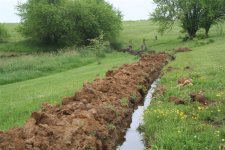ampsucker
Platinum Member
ahhh, you can really tell this is a tractor website! all the ideas involve moving tons of rock or dirt!
i'll throw this out: how about working "with" the earth and planting a series of trees, shrubs and grasses to help prevent erosion and slow the flow of water. you might try doing a little research to see what grows naturally in your area and is flood tolerant. usually birches, willows, switch grass, cat tails, marsh plants, etc.
i do agree that the normal solution is to dig a trench or channel wide enough to handle peak flow and contain it during flooding periods. this is how they handle water control "in towns". but, i think you have the advantage of having the second option of basically creating a huge "rain garden" (google it if you don't know about this trend) and then you'll have a nice wildlife habitat during low water conditions instead of a big ugly hole waiting for water to fill it a couple of times a year.
amp
i'll throw this out: how about working "with" the earth and planting a series of trees, shrubs and grasses to help prevent erosion and slow the flow of water. you might try doing a little research to see what grows naturally in your area and is flood tolerant. usually birches, willows, switch grass, cat tails, marsh plants, etc.
i do agree that the normal solution is to dig a trench or channel wide enough to handle peak flow and contain it during flooding periods. this is how they handle water control "in towns". but, i think you have the advantage of having the second option of basically creating a huge "rain garden" (google it if you don't know about this trend) and then you'll have a nice wildlife habitat during low water conditions instead of a big ugly hole waiting for water to fill it a couple of times a year.
amp

